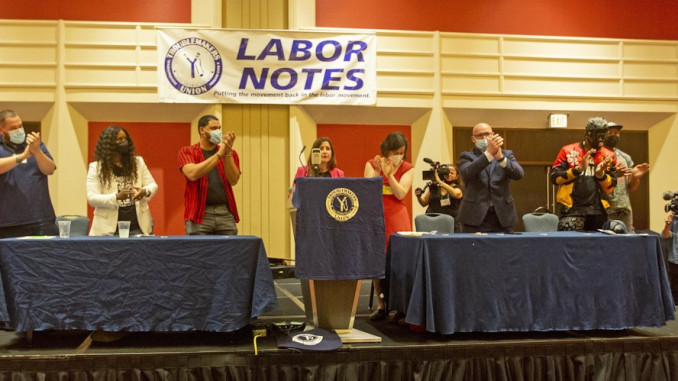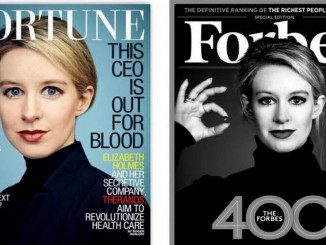
Reprinted from the website of the New Anti-capitalist Party (NPA) in France. Written by an NPA worker activist who attended the Labor Notes conference in Chicago April 21-24. Published on April 30, 2024.
The “Labor Notes” conference gathered this year under the motto, “Putting the movement back into the labor movement.” This conference is held every two years and aims to bring together union activists from across the country, and beyond. The bet was more than successful for this 2024 edition, held from April 19 to 21! Nearly 5,000 “activists” gathered, probably half coming from student, teacher, and unionist milieus and the other half being activists from the auto, health, Amazon, and aeronautics sectors (plus others from Boeing who also want to give their opinion on the safety of the company’s planes whose doors fly off!). There were actors and screenwriters from the strike in Hollywood, railway workers, and even the famous “Teamsters,” who are the truck drivers that crisscross American roads. Among other revolutionary activists and activist publishing houses from the United States, activists from the NPA-Revolutionaries from France and activists from the RSO from Germany, alongside activists from Speak Out Now (a revolutionary organization in the United States) were present to experience the American worker’s dream, live!
Things are shaking up!
The atmosphere of the weekend was marked from start to finish by the recent success of the auto workers’ strike against the “Big Three,” the country’s three main car manufacturers: General Motors, Ford, and Stellantis (i.e., Fiat-Chrysler and PSA). This was a victorious strike, despite some limitations, and was widely perceived as such. The 25% salary increases won over the next four years, coupled with the elimination of salary inequalities between generations, allowed certain workers to see their salaries double as soon as the strike ended (from 21 dollars to 42 dollars per hour). There was also the victorious strike for Hollywood screenwriters and various series. There were also mobilizations among truck drivers, at Amazon, at Starbucks, among nurses, and even among high school teachers, some of whom proudly explained that they had defied the legal bans on striking in several states of the country.
The icing on the cake was the success announced during the conference, of the recognition of the UAW union (United Automobile Workers – the union at the origin of the strike against the Big Three) at the Volkswagen factory in Chattanooga in Tennessee by a “yes” vote of 73% with participation of more than 83% of the workers. It is the first success of this type in at least several decades. And everyone immediately explained that the next strike will be against the “Big Four” (General Motors, Ford, Stellantis, and now Volkswagen). Suffice it to say that for several sectors the feeling of confidence in one’s own strength, and in the ability to concretely push back the employers was alive and well. It was an opportunity to feel refreshed, from upbeat meetings to more personal discussions among workers who are feeling strong and proud of their struggle.
At 30, you have the whole class struggle ahead of you!
Of course, this was a gathering over a weekend, which concentrated in the same place forces that undoubtedly dispersed the rest of the time. But what was extremely striking during these three days of conference and its approximately five hundred debate workshops was the youth and determination of the participants. At the heart of the life in these workshops is a new generation of trade unionists, aged 30 and over, who offer the image of the American working class in struggle: one nurse, a trade unionist since 2022 in her hospital, explained that she was radicalized following the assassination of George Floyd; an auto worker, now a leader of the UAW, wore a cap bearing the image of the IWW (Industrial Workers of the World, an American revolutionary union founded at the beginning of the 20th century) and explained that every worker must now organize and take charge of their struggle against the bosses; or a Black mother from Alabama, a worker at Hyundai, in a self-contained factory, working ten hours a day and six days a week, not including compulsory overtime, but who is at the forefront of the class struggle of this militant generation and now wants to extend class-struggle unionism to the South of the country. The UAW, which has 150,000 members, announced that it aims to double its membership by unionizing the South. Knowing that only 7% of employees are covered by a collective contract (equivalent to collective agreements), the task is huge. However, it is necessary in the face of the rapaciousness of big American employers, particularly in auto where the bosses are ready to fight back. Even after the UAW’s victory, an activist testified to the disappearance of all the chairs in one of the Ford factories: “You are for a stand-up strike? Well, you will work standing up!” explained the management in revenge.
Another ambitious objective submitted for discussion by the UAW: the prospect of a general strike for… 2028! In May 2028, the newly won collective agreement in the automobile industry will expire. The UAW leadership therefore proposes to all other unions that all collective agreements in the country be concluded at the same time. The goal: to put pressure on everyone through a common strike in different sectors. “All together” yes… but four years from now? The idea seems strange and very distant. But after all, why should only employers make plans in advance? Whatever happens, the class struggle will not take a four-year break. Nothing says that workers will be as patient as their union leaders!
A revival of class struggle unionism?
The ambition is great. But it does not seem impossible given that, as the exploitation has become tougher, part of the trade union movement has decided to respond with tougher social confrontation. The new activists and leaders of this fringe of the American labor movement proudly claim to be “troublemakers” (enough to make Gabriel Attal pale, who proposes to include this label in the grade books of so-called bad students in France). They announce that they want to break with the practices of class collaboration that have openly taken place in recent decades. The auto strike, named a “Stand-up Strike,” was instigated by the new leadership of the UAW, which was narrowly won (7 delegates out of 13 to the national leadership) by Shawn Fain and his union tendency, the UAW-D (Unite All Workers for Democracy). They announced that they want to rebuild worker unionism, class struggle without compromise or corruption. The speech was intended to be internationalist. Shawn Fain and Cesar Orta (Mexican auto unionist) shared the same platform during the closing meeting.
This fight for democracy, this renewal of trade unionism is also intended to be anchored in a vast set of very codified, very professional activist practices, described precisely in manuals including “The Secrets of a Successful Organizer,” which offer ideas for what workers can do by and for themselves and not what unions can do for them. It reads, among other things: “Organizing workers involves much more listening than talking. Try the 80/20 rule – listen 80% of the time and talk 20%. Or at least reduce your share to a third: you have two ears and a mouth, so use them proportionately”!
Things are moving in the factories… and in people’s minds!
Certainly, the auto “Stand-up Strike” was entirely and consciously organized from the top down by this new union officialdom and the strikers had no say in its actual conduct. This was just like the strike canceled by the newly elected officials of the Teamsters union last summer. These union officials are ready to mobilize or even strike as long as they maintain control and the specter of the possible spread of the strike is averted. In terms of workers’ democracy, we have seen better! These limits and contradictions do not (yet) bother the participants. At the current stage of these developments, in addition to this renewed combativeness and collective organization in the working class, many questions, including an examination of certain essential policies, are already beginning to emerge. However, the radicalism and internationalism of the new leadership of the UAW have one hell of a limit: that of having officially endorsed Joe Biden for the next presidential election. But many present at the conference couldn’t turn a blind eye to the genocide underway in Gaza, made possible by the weapons provided by this same Biden. A demonstration of solidarity with the Palestinian people, impromptu and unplanned by the organizers, even triggered a police intervention in front of the conference venue.
As for the presidential election, activists say that it is with death in their souls that they will block Trump by holding their noses and voting for Biden. Others, a minority, but who were also applauded in the discussions, say that we must chart another path, perhaps not stick only to union struggles, however radical these may be. So, what to do? Build a workers’ party in the United States, of which these young worker activists would be the backbone? Who knows! But people are really thinking about the next step and how to solve all the political problems by and for the workers. Let’s leave the final word to a trade unionist who explained from a conference panel: “Once again, we are being forced to choose between two candidates who we do not like. But in 2028, maybe the choice will be to present our own candidate.”




